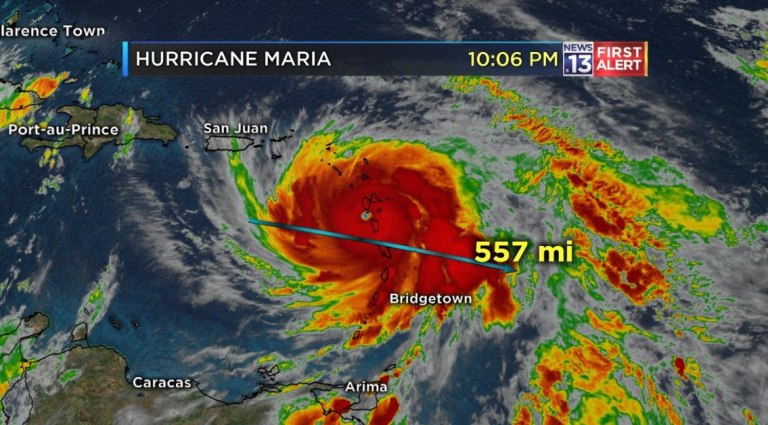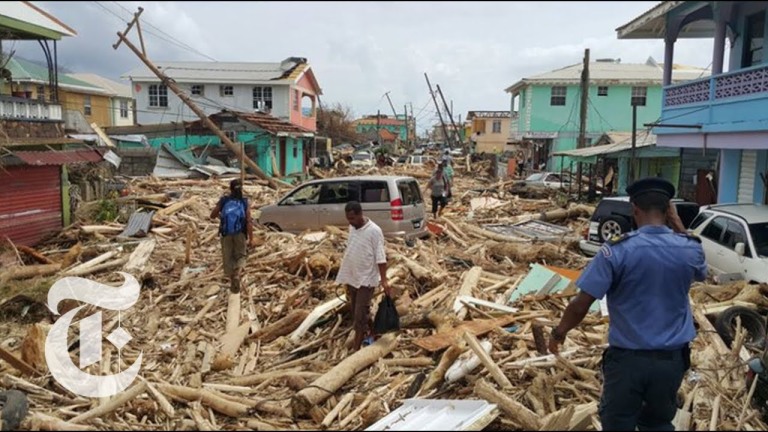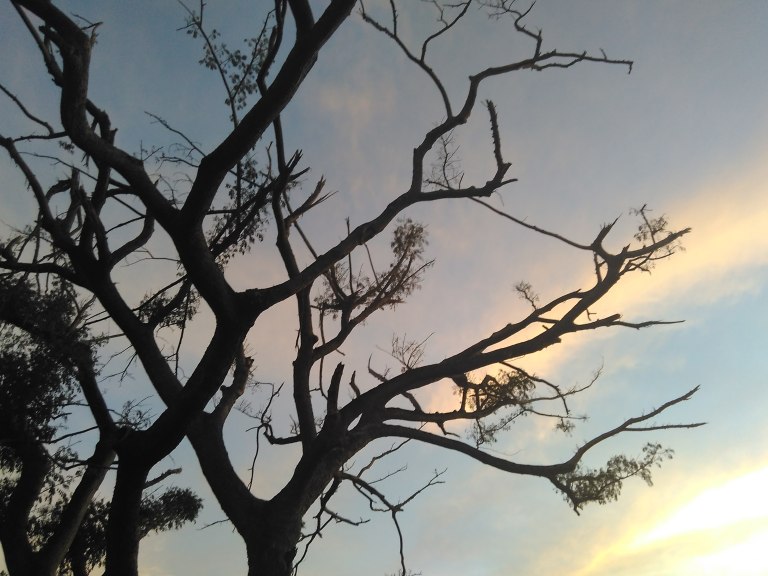“To deny climate change is to deny a truth we’ve just lived.”
– Roosevelt Skerrit, Prime Minister of Dominica in a speech to the UN General Assembly, September 23rd, 2017
The island of Dominica sits north of Saint Lucia, on a four-hour ferry that bucks and rocks its way across the Atlantic. It’s a lean island: 29 miles long and 11 miles wide. The Caribs, the indigenous people of Dominica, named their home Wai‘tu kubuli, which means, “Tall is her body.” In tourist parlance, it’s called “the nature island of the Caribbean”. Although not as developed as St. Lucia, it offers up startling landscapes: Mountains that plunge into the ocean, boiling lakes, and sulfur springs. The island has more rivers than days in a year.

I’m standing at a parish center on top of a hill in the neighborhood of Morne Bruce, in the capital Roseau. It’s evening. I’m at the home of Monsignor John Lewis, a debonair Dominican priest who hugs me like we are long lost family members. John Lewis wears both a smile and a panama hat with elegant ease, and he looks about forty-five.
We are here to celebrate his seventieth birthday. There are two tables set up in the Parish’s back yard overlooking the city and the flat, placid ocean. The table is piled high with passion fruit rum punch, ginger beer, fried chicken and finger sandwiches. The other guests wear flamboyant Easter hats and laugh loudly, the colors dimming as the sun goes down. I’m here with Dan, Mike and Tiffany, my colleagues and friends. Mike is a tall, thin, animated St. Lucian in John Lennon glasses. He’s enthusiastic, making me try drinks, pointing out flowers, teaching me the words to local songs. As we stand there, he points out the old barren trees that frame the view of the city. “There used to be many more old trees here.” He says, his voice softening. “Before Maria.”

Hurricane Maria started as a tropical tidal wave southwest of Cape Verde. On September 16th, 2017 this wave moved west, gaining speed and momentum and becoming a tropical storm. Within 24-hours, Tropical Storm Maria doubled its wind speed, becoming a category five hurricane and slamming into Dominica with almost no warning. When Maria made landfall on September 18th at 9:30pm, her top windspeeds were 155 mph/hour. The strongest hurricane to ever hit the island.
“We were hearing different things.” My colleagues told me earlier that day. “The government was saying that it was just a category one hurricane, something we’re used to. But our families abroad were sending us messages saying the U.S. news reported it as a category three and growing. No one knew what Maria was going to turn into. We had no time to prepare.”

Mike was one of the first responders after the hurricane and he’s been here ever since. When he talks about the hurricane, his body language changes. He gets quieter. “Everyone said the storm sounded…” He pauses, the light of our cell phones glinting off his glasses. He’s leaning down closer to me. He wants me to lean in too, to hear this, to understand.
“Hurricane Maria sounded like growling. A pack of wild animals right outside your door. Every feral sound you can imagine: scratching, howling, gnashing of teeth, rattling your windows, slamming into your door frame. The storm was a monster. It didn’t matter what kind of man you thought you were before the storm. When your house is shaking and Maria is snarling, you’re afraid.”
Maria battered the island for twelve hours. The storm combined strong wind with torrential rain fall, overwhelming Dominica’s hundreds of rivers, causing flash floods that wiped out entire communities and flooded the capital with feet of mud and debris. When the storm finally passed, people opened their doors to an unrecognizable scene. Whole forests gone. Communities leveled. Apocalyptic landscapes. There was no radio communication, no cell phone service, no power, no water. People were trapped by fallen trees and debris. There was no way to see if families and friends in other communities had survived. For a whole week Dominica was a communication dead zone. Only a few rogue ham radio operators could send out pleas for help.

Mike continues. “After the hurricane, there was not a single leaf on any tree on the island. Every tree was stripped completely bare.” Monsignor steps in, “it stripped the bark off trees. Can you imagine the strength of wind necessary to strip bark off trees?”

“You looked up at the mountains,” Monsignor continues, gesturing to the darkening hills around us. “And it looked like someone had raked their fingers through the earth. The hurricane ripped the vegetation and the earth crumpled.” Both Mike and Monsignor stand with their hands on their hips, heads bowed.
Dominica was decimated. The statistics are stark: 100% of people on the island were impacted by the storm, through destruction of their homes or loss of livelihoods. 100% of agriculture on the island was destroyed. 31 people were killed, and 30 are still missing. This was not a storm that just affected the poor and vulnerable, although as always, they suffered the worst and longest lasting repercussions. Maria hit so quickly the Prime Minister had to be evacuated from his home when it started flooding. The roof of the Archbishop’s house was ripped away. No one on the island escaped the hurricane.
In the days following the disaster, neighboring countries and humanitarian organizations rushed to Dominica to respond. Coordination was as swift as possible to bring in food baskets and tarpaulin and water systems. The government imposed a curfew and rations on bread, sugar, and milk. Desperate looters raided supermarkets and stores. Seven months later, 80% of Dominica still doesn’t have power. 400 people are still living in emergency shelters. While the roads have been cleared, the destruction is still apparent. Tree trunks the size of cars lie scattered in fields. Concrete retaining walls crumble into the street. Downed power lines are everywhere: snaking across the pavement and into gutters. Looking out from the parish in the waning light, most of buildings still don’t have proper roofs. 90% of buildings in the country were damaged, and the sounds of hammering and chainsaws float across the city, a constant symphony of reconstruction.
I feel a little off balance, standing at such a lively party in the middle of leveled city. Mike pivots away from me to talk to a miniature elderly woman with a poof of white hair, who is giggling and reaching for his arm. Monsignor points to a garden statue of St. Francis of Assisi, standing on a rock with his arms outstretched. “St. Francis was untouched by Maria.” He says, tapping me on the shoulder. “Patron Saint of the Environment, you know.”

Everywhere you see people adapting and modifying their lives. An older lady named Marjorie, in a pink hat with fabric orchids, tells me her ginger beer recipe. “Water, and you grate a whole lot of ginger into the bottle. Then sugar and a handful of rice. Usually it needs lime, although we don’t have that anymore so if I can find it I use bottled lemon juice.” Dominica used to be the bread basket of the Caribbean, but due to crop disease and the hurricane, there is nothing. There is not a single piece of citrus fruit on the island.
Every situation report out of the major international organizations says the situation here is normalizing. Most schools have reopened. Government services have started back up. Shop keepers are throwing open their doors again for business. What the situation reports don’t say is how my colleagues still get a far-off look in their eyes when they talk about the storm. It’s the subject we always return to. What happened and what still needs to be done. The talk radio hosts berate the government for no action in preparation for the upcoming hurricane season, which starts June 1st. A nurse tells me that people still come to the ER everyday with panic attacks induced by a sudden rainfall or a gust of wind. In downtown Roseau, there are piles of rubble from destroyed homes where people know the bodies of their family members still lie. The trauma of a storm like Maria lingers.
The sun has disappeared beneath the horizon, and the other guests are starting to go home. What is happening now,” Monsignor says as the party clears and the yard goes quiet, “Is the depression. It is taking a long time to rebuild houses. It takes a long time to return to normal. People have been living with the aftermath of this storm for a long time, and the next hurricane season is just around the corner. People feel scared, sad, hopeless.”

The 2017 Hurricane season was the costliest on record, an estimated US $265 billion in damage in the Caribbean and in the United States. There were thirteen named storms, six major hurricanes, three of them back-to-back, two of them category five. Hurricane Irma was the strongest hurricane in recorded history in the Atlantic. Maria hit just two weeks later. After Dominica, Hurricane Maria paused before gaining strength and smashing into Puerto Rico. There is no indication that these disasters will slow down. Dominicans know this. St. Lucians know this. Puerto Ricans know this. The Catholic Church knows this. Pope Francis released Laudato Si, his second encyclical that recognizes a changing climate and calls on humanity to take care of our “common home.” Climate change is only fiction for those who have the luxury to ignore it. Or for those who profit off its denial.
Monsignor points to a lush tree that stands above the tables. “After the storm, this tree had not a single leaf. As the weeks passed I would update my congregants. The almond tree has three leaves! This week the almond tree has six leaves! I wanted to show them hope, that things were growing back. And now look: it’s almost recovered.”
Marjorie, maker of ginger beer, echoes the sentiment. “Dominicans, we are always joking. We can make a joke out everything, and we do! You have to laugh,” She gestures out to the view, the half-lit city, the downed trees and power lines, the exposed rooftops, “In the face of all of this.”
The party is over. The back yard is completely dark. The city emits so little light that the sky expands to embrace the sea, and the darkness glimmers with infinite stars and their reflection in the water. Mike and Monsignor start to sing, linking arms and swaying side to side:
Nenen anu bwewomnu (godmother let us drink our rum)
Sometimes it’s Roseau
Sometimes it’s Morne Bruce
Sometimes it’s Cemetery
“The song is about enjoying the moment. You have to celebrate! Every. Single. Day.” Monsignor chops the air with his hand for emphasis. “Because you never know what’s going to happen tomorrow.”
